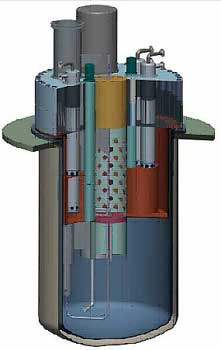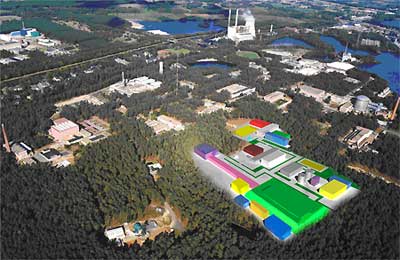

SCK•CEN (the Belgian Nuclear Research Centre)
is a candidate for hosting a European fast spectrum experimental
facility for demonstrating efficient transmutation and associated
technologies using a system that works in sub-critical and/or
critical mode. With this in mind, SCK•CEN started, in 1998,
designing the MYRRHA facility as an accelerator driven system
(ADS) with the following objectives:
-
To demonstrate ADS technology, full-scale,
within the framework of research into the transmutation of
high-level waste
-
To serve as a flexible fast spectrum irradiation facility
for testing materials and innovative fuels for ADS and
GEN IV systems
and fusion reactors
-
To contribute to the technological demonstration of the
GEN IV Lead Fast Reactor
-
To perform fundamental and applied physics research
making use of SCK.CEN’s high power proton accelerator
MYRRHA should be operational in 2020 and is designed as an open
user facility for the international research community in the
fields of physical science, waste transmutation, nuclear engineering,
radioisotope research and production, as well as for material
and nuclear fuel science.
Since the start of the FP6 EUROTRANS integrated
project launched by the European Commission in 2005, MYRRHA has
served as a basis for a small-scale, short-term experimental
facility demonstrating the technical feasibility of “Transmutation
in an Accelerator Driven System (XT-ADS)” machine. The
main parameters and characteristics of the MYRRHA facility are
as follows:
-
The MYRRHA accelerator is based on LINAC technology
in order to fully demonstrate the industrial scale ADS and
to meet the very demanding conditions in terms of beam reliability
(reduction of the number of beam trips longer than 1 second,
up to a maximum of 10 to 20 trips per year)
-
The windowless spallation target concept
of MYRRHA has progressed in terms of design and demonstration
on the
basis of an important
international experimental programme complemented by an
international Computational Fluid Dynamics (CFD) effort
for the free surface
treatment. The evidence of the feasibility of the proposed
design is no longer questioned with respect to its fundamental
aspect,
but some issues still remain open with regards to its fine
tuning and advanced design, which will be addressed over
the next 3
years
-
The core maximum sub-criticality level
of keff ~ 0.95 assures a comfortable margin
for safe operation. The
total power
ranges from between 50 to 80 MWth (depending on the core
loading and
the experimental rigs inserted). The total neutron flux
levels (1 1015 to 5 1015 n/cm².s)
achieved in large irradiation volumes in the core (about
20.000 cm³ in total) enable
very high performance testing conditions
-
The MYRRHA fuel design is based on fast
reactor (FR) MOX fuel technology (30% Pu contents) with T91
ferritic-martensitic
steel
for the cladding and for the fuel assembly wrapper.
The inlet
temperature is 300°C and the outlet temperature is 380°C.
The targeted fuel residence time is 3 years. Nevertheless,
the MYRRHA core is designed to accept minor actinide based
fuel assemblies
whenever these are made available
-
The primary system of the MYRRHA facility
is based on a pool design cooled with Pb-Bi as a primary
coolant (see figure 1) and boiling water as a secondary fluid.
The heat exchangers and primary pumps are immersed in the
reactor vessel in dedicated casings. Interim fuel storage
inside the primary vessel can host the used fuel for decay
heat before transfer out of the vessel
-
The MYRRHA building was conceived from
the very beginning to take into account remote handling and
robotics based
operation and maintenance within a controlled atmosphere,
limiting
the LBE contamination by O2 trapping. The
remote handling for both out-of-vessel and in-vessel
operation and
maintenance
was developed using existing and demonstrated technology
in the Joint European Torus (JET) fusion facility.
 Figure
1: Vertical cut of the MYRRHA/XT-ADS sub-critical reactor
In April 2008, SCK•CEN, together with
its European partners, answered a FP7 call for establishing a
Centralised Design Team for a Fast Spectrum Transmutation Experimental
Facility to be able to work in sub-critical and/or critical mode.
Within this framework and starting in 2009, the MYRRHA/XT-ADS
design will be updated to allow for critical mode operation.
The partners involved are the following research organisations:
CEA (FR), CNRS (FR), FZK (DE), FZD (DE), CIEMAT (ES), ENEA (IT),
NRG (NL) and ITN (PT). From the nuclear industry the partners
involved are: Ansaldo Nucleare (IT), Del Fungo di Giera Energia
S.p.A. (IT), AREVA NP S.A.S (FR), Empresarios Agrupados (ES),
SENER (ES), ADEX (ES), OTL (UK) and CRS4 (IT). Also involved
are two universities: UPM (Spain) and UPV (Spain). Since the
MYRRHA project is moving to an industrialisation phase, the partners
leading the major work-packages are from the nuclear industry.
The MYRRHA project (technical description and
business plan) has been submitted to the Belgian minister of
energy with a request for financial support for a significant
part of the cost of the initial engineering phase of MYRRHA and
for its final realisation at a later stage. As a result, in the
governmental agreement signed by the new "Leterme I" Belgian
federal government, which was formed in March 2008, support for
the MYRRHA project is regarded as an international research infrastructure
that serves research programmes looking at the reduction of long-lived
waste and the production of radio-isotopes for medical applications.
Currently, SCK•CEN is in discussion with the Belgian government
to set the specific requirements and conditions of this support.
A detailed business plan for MYRRHA exists (MYRRHA
Project – Business Plan 2007, SCK•CEN Report, reference
ANS/HAA/DDB/3900 B043000/85/07-17, April 2007). From the plan
it is possible to identify a total investment cost, expressed
in 2007 values and spread over 12 years, of ~700 M€. The
operational costs are estimated to be 38 M€ per year.
The 2007 R&D programme for MYRRHA at SCK•CEN
features various highlights. Here are some of them:
-
The primary and secondary system component
configurations were further elaborated and optimized. The
system components were calculated in detail. The diaphragm
separating
the hot and cold lead-bismuth coolant in the reactor vessel
was largely simplified. This new configuration of vessel
components
resulted in an enhanced capacity for natural circulation
in emergency situations. The specifications for the experimental
devices (in
pile sections) were formulated according to the MYRHA/XT-ADS
objectives and adapted to the actual core and core support
structure design
-
The neutronic calculations for MYRRHA/XT-ADS
were mainly focused on two topics. Firstly, the estimation
of the neutron
induced
damage (dpa) on the core barrel and top grid. This led
to a recommendation to increase the core by two extra rows,
thereby increasing the
space between the last row of fuel assemblies and the core
barrel. Secondly, calculations were performed to estimate
the neutron
fluxes in the eight in-pile-positions. In addition, scoping
calculations for a burn-up cycle and reshuffling scheme
were made
-
The issues of vacuum and lead-bismuth conditioning
for the windowless spallation target were addressed through
dedicated
experiments, including experiments simulating the proton
beam surface heating with an electron beam (WebExpIr).
It was shown
that the high intensity heating has no distortive effect
on the target surface flow and that the vacuum conditions
remain well
within the operational limits
-
One of the fundamental design options is
that all maintenance and in-service inspection and repair
duties in MYRRHA
will be performed by remote handling. In view of this,
a first
version
of the Remote Handling Design Catalogue (RHDC) for
MYRRHA/XT-ADS was released. This RHDC provides information
and guidance
to engineers, CAD designers and technicians with a
view to ensuring
that the MYRRHA/XT-ADS machine, as well as its remote
maintenance system, is designed in a way that is fully
compatible with
the remote handling requirements. The catalogue contents
were finalised
in cooperation with Oxford Technologies, taking advantage
of their experience with the fully remote maintenance
of the EFDA-JET
Fusion Tokamak project
-
Significant progress was made with the
development of ultrasonic techniques for visualisation in
liquid
lead-bismuth
under gamma
radiation. An acoustic computer model was developed
and validated on a mock-up in water. The research
to improve
the diffusion
bonding process to obtain a reliable ultrasonic transducer
for application in LBE is ongoing
-
Material irradiations in stagnant lead-bismuth
in the BR2 reactor have been performed to investigate
the behaviour
of the fuel
cladding and structural materials, considered for
MYRRHA/XT-ADS,
in representative conditions. The samples are being
analysed during the course of 2008
-
As a first step towards the development
of MYRRHA the GUINEVERE project was launched and formally
accepted by the Governing
Council of IP-EUROTRANS, in December 2006. GUINEVERE
is a zero-power mock-up of the MYRRHA/XT-ADS
with, as
its
main
objectives,
the
qualification of the sub-criticality monitoring
techniques and its role as a validation model
for the core neutronic
design. GUINEVERE should provide answers to these
questions by 2009-2010.
To achieve this goal, the zero-power critical
facility VENUS facility at SCK•CEN is being adapted to a zero-power
lead fast reactor and coupled to a modified GENEPI deuteron
accelerator
delivering 14 MeV neutrons by bombarding deuterons on a tritium-target
-
An important milestone reached was the
delivery of CEA fuel for GUINEVERE to SCK•CEN, in October and November
2007. Also a derogation to the standard licensing procedures
was
requested in November 2007. This request was approved by
the Minister of
Internal Affairs, in March 2008. The construction permit
has been received in April 2008. The first phase of the licensing
procedure was successfully completed in May 2008.
-
A full plant layout of the MYRRHA complex
has been drawn up on the SCK•CEN technical site at Mol, see figure
2

Figure 2: MYRRHA Plant layout on the SCK•CEN
technical site at Mol (BE)
Contacts:
Hamid Aït Abderrahim (hamid.ait.abderrahim@sckcen.be)
Peter Baeten (peter.baeten@sckcen.be)
Didier De Bruyn (didier.de.bruyn@sckcen.be)
myrrha@sckcen.be
www.sckcen.be/myrrha
|

